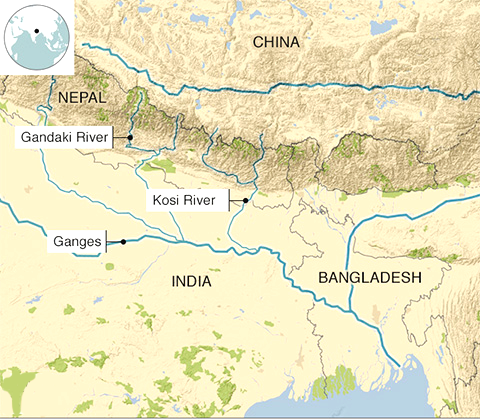Sapta Kosi High Dam Project | 04 Oct 2022
For Prelims: India Nepal Relations, Sapta Kosi High Dam Project, Mahakali Treaty, India Nepal Border
For Mains: India-Nepal Relations and recent developments, Sapt Kosi High Dam Project, Mahakali Treaty
Why in News?
Recently, India and Nepal have agreed to take forward the Sapta Kosi high dam project through further studies.
- Senior officials of the two sides have met and reviewed the bilateral water-sector cooperation, including the implementation of the Mahakali Treaty.
What is Sapta Kosi High Dam Project & Mahakali Treaty?
-
-
Sapta Kosi High Dam is a multipurpose project proposed to be constructed on the Saptakoshi River of Nepal (Known as Kosi River in India).
-
The project is primarily aimed to control floods in south-east Nepal and northern Bihar and to generate hydropower.
-
The project will provide irrigation, control floods and generate 3,000 MW of electricity.
-
-
- The Mahakali Treaty was signed in 1996 over the integrated development of the Mahakali River, including Sarada Barrage, Tanakpur Barrage and Pancheshwar project.
- Mahakali River is also known as Sharda River or Kali Ganga in Uttarakhand.
- It joins Ghagra river in Uttar Pradesh, which is a tributary of Ganga.
What do we know about the Kosi River System?
-
The Kosi is a trans-boundary river which flows through Tibet, Nepal and India.
-
It has its source in Tibet that includes the world's highest upland, it then drains a large part of Nepal before emerging onto the Gangetic plains.
-
Its three major tributaries: the Sun Kosi, Arun and Tamur meet at one point just upstream of a 10 km gorge cut through the Himalayan foothills.
-
The river crosses into northern Bihar, India where it branches into distributaries before joining the Ganges near Kursela in Katihar district.
-
The Kosi carries the maximum amount of silt and sand after the Brahmaputra in India.
-
It is also known as the “Sorrow of Bihar” as the annual floods affect about 21,000 sq. km. of fertile agricultural lands thereby disturbing the rural economy.
What are some other Recent Developments in India Nepal Relations?
-
Build Own Operate and Transfer (BOOT):
-
A Memorandum of Understanding (MoU) was signed between the Government of Nepal and Sutlej Jal Vikas Nigam (SJVN) Limited for the project in 2008 for execution on a Build Own Operate and Transfer (BOOT) basis for a period of 30 years including five years of the construction period.
-
-
Hydropower Projects:
-
Nepal also invited Indian companies to invest in the West Seti hydropower project in Nepal.
-
-
Cross-border Rail Link:
-
The operationalisation of the 35 kilometers cross-border rail link from Jayanagar (Bihar) to Kurtha (Nepal) will be further extended to Bijalpura (Nepal) and Bardibas (Nepal).
-
UPSC Civil Services Examination, Previous Year Questions (PYQs)
Q. Consider the following pairs: (2016)
| Community sometimes mentioned in the news | In the affairs of |
| 1. Kurd | Bangladesh |
| 2. Madhesi | Nepal |
| 3. Rohingya | Myanmar |
Which of the pairs given above is/are correctly matched?
(a) 1 and 2
(b) 2 only
(c) 2 and 3
(d) 3 only
Ans: (c)
Exp:
-
Kurd: They are one of the indigenous peoples of the Mesopotamian plains and the highlands in what are now South-eastern Turkey, North-eastern Syria, northern Iraq, North-western Iran and South-western Armenia. They also adhere to a number of different religions and creeds, although the majority is Sunni Muslims. Hence, pair 1 is not correctly matched.
-
Madhesi: It is an ethnic group living mainly in the southern plains of Nepal, close to the border with India. Madhesis are predominantly Hindus with some Muslims and Christians. Hence, pair 2 is correctly matched.
-
Rohingya: They are an ethnic group, largely comprising Muslims, who predominantly live in the Western Myanmar province of Rakhine. They speak a dialect of Bengali, as opposed to the commonly spoken Burmese language. According to Myanmar authorities, they are not the authorized citizens of the country. Hence, pair 3 is correctly matched.
-
Therefore, option (c) is the correct answer.


